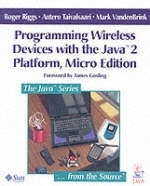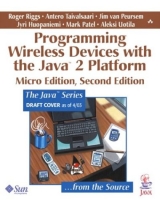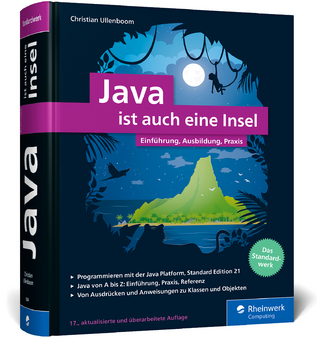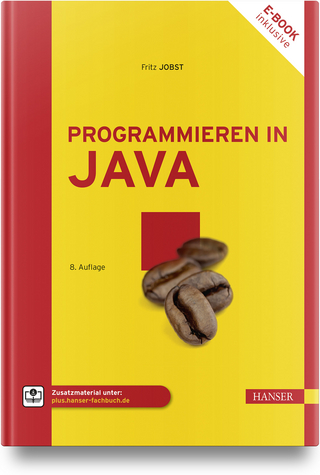
Programming Wireless Devices with the Java™ 2 Platform, Micro Edition
Addison Wesley (Verlag)
978-0-201-74627-3 (ISBN)
- Titel erscheint in neuer Auflage
- Artikel merken
Sun's J2MEaA A Platform brings unprecedented power and platform independence to the wireless market. Sun has collaborated with virtually every wireless leader, including Motorola, Nokia, NTT DoCoMo, Palm, RIM, and Siemens. Now, a team of J2ME creators and leading-edge developers have come together to present the definitive guide to real-world J2ME development. Whether you're building next-generation cell phones, two-way pagers, personal organizers, or any other wireless device, this book delivers the specific techniques you need to succeed. Programming Wireless Devices With the J2MEaA A Platform starts with a much-needed general introduction and technical overview of J2ME technology and standards, and presents detailed case studies demonstrating J2ME at work in actual applications. The authors introduce key J2ME standards such as Connected, Limited Device Configuration (CLDC) and Mobile Information Device Profile (MIDP); and show how to maximize performance, portability, and consistency in real-world J2ME development.For wireless developers, consumer and embedded systems engineers, and all Java developers who want to leverage their expertise in next-generation wireless application development.
Roger Riggs is a senior staff engineer at Sun Microsystems who focuses on design and architecture of the Java 2 Micro Edition platform for wireless devices. He led Sun¿s efforts within the Java Community Process to standardize the MIDP 1.0 and 2.0 APIs. Antero Taivalsaari is a senior staff engineer at Sun Microsystems. Dr. Taivalsaari co-founded the Spotless project at Sun Labs, and designed the original KVM system that became the cornerstone of the Java 2 Platform, Micro Edition. In addition, he led the CLDC 1.0 and 1.1 standardization efforts. Mark VandenBrink is Chief Architect for systems software at Motorola Semiconductor Products Sector, where his team has been working on KVM-based wireless technology for over three years. He was the leader of the Mobile Information Device Profile standardization effort, and a member of the Connected Limited Device Configuration expert group. 0201746271AB05222003
Figures.
Preface.
1. Introduction.
The Wireless Internet Revolution.
Why Java Technology for Wireless Devices?
A Bit of History.
J2ME Standardization Efforts.
2. Overview of Java 2 Platform, Micro Edition (J2ME).
Java 2 Platform.
Java 2 Platform, Micro Edition (J2ME).
Key Concepts of the J2ME Architecture.
Introduction to the K Virtual Machine (KVM).
3. Goals, Requirements and Scope.
High-Level Goals.
Target Devices.
General Notes on Consumer Devices and Embedded Systems.
Requirements.
Scope of the CLDC and MIDP Standardization Efforts.
4. High-Level Architecture and Security.
High-Level Architecture.
Security.
5. Connected Limited Device Configuration.
Introduction.
CLDC Application Model.
Java Language Specification Compatibility.
Java Virtual Machine Specification Compatibility.
6. CLDC Libraries.
Background and Goals.
Classes Derived from J2SE60.
CLDC-Specific Classes.
7. Mobile Information Device Profile.
MIDP Expert Group.
Areas Covered by the MIDP Specification.
8. MIDP Application Model.
Limitations of the CLDC Application Model.
MIDlets.
MIDlet Suites.@AHEADS = MIDP System Software.
9.IDP User Interface Libraries.
Structure of the MIDP User Interface API.
Abstract Commands.
Interactions with MIDlet Application Lifecycle.
Graphics and Canvas in the Low-Level API.
Low-level API for Events in Canvases.
Graphics Drawing Primitives.
Creating and Using Images.
Using Screens.
Using Items.
A Note on Concurrency.
10. MIDP Networking Libraries.
Characteristics of Wireless Data Networks.
Network Interface Considerations.
The HttpConnection Interface.
Sample Code (NetClientMIDlet.java).
11. MIDP Persistence Libraries.
The Record Management System.
Manipulating Record Stores and Records.
Sample Code (RMSMIDlet.java).
12. Additional MIDP APIs.
Timer Support.
System Properties.
Application Resource Files.
Exiting a MIDlet.
13. Sample Applications.
The PhotoAlbum Application.
The AddressBook Application.
The Sokoban Game Application.
Development Environments for J2ME.
14. Summary.
Appendix A. CLDC Application Programming Interface.
ALMANAC LEGEND.
java.lang.
java.io.
java.util.
javax.microedition.io.
Appendix B. MIDP Application Programming Interface.
java.lang.
java.util.
javax.microedition.io.
javax.microedition.lcdui.
javax.microedition.midlet.
javax.microedition.rms.
Index. 0201746271T04232001
| Erscheint lt. Verlag | 4.7.2001 |
|---|---|
| Verlagsort | Boston |
| Sprache | englisch |
| Maße | 185 x 235 mm |
| Gewicht | 569 g |
| Themenwelt | Informatik ► Programmiersprachen / -werkzeuge ► Java |
| Mathematik / Informatik ► Informatik ► Web / Internet | |
| ISBN-10 | 0-201-74627-1 / 0201746271 |
| ISBN-13 | 978-0-201-74627-3 / 9780201746273 |
| Zustand | Neuware |
| Informationen gemäß Produktsicherheitsverordnung (GPSR) | |
| Haben Sie eine Frage zum Produkt? |
aus dem Bereich



